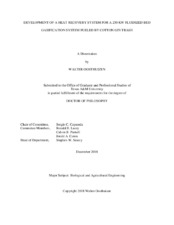| dc.contributor.advisor | Capareda, Sergio C | |
| dc.creator | Oosthuizen, Walter | |
| dc.date.accessioned | 2021-01-12T17:13:38Z | |
| dc.date.available | 2021-01-12T17:13:38Z | |
| dc.date.created | 2018-12 | |
| dc.date.issued | 2018-09-24 | |
| dc.date.submitted | December 2018 | |
| dc.identifier.uri | https://hdl.handle.net/1969.1/192033 | |
| dc.description.abstract | Disposing of cotton gin trash (CGT) at gins has been an issue for decades. Instead of a waste byproduct, CGT can be utilized as a sustainable fuel for fluidized bed gasification (FBG). The overall objective of this project was to design and evaluate a FBG system, capable of supplying 250 kWₑ of electricity, for commercial manufacturing. Additional research was needed for a heat recovery system (HRS) such that the system could be classified as cogeneration. Two sources of waste heat from the FBG system were identified as syngas and generator exhaust gases. Design of multiple counter-flow heat exchangers heated ambient air to supply thermal energy to gins to reduce fuel usage, resulting in yearly economic savings.
A small-scale heat exchanger was evaluated for syngas cooling, where gasification tests revealed that a fouling layer reduced heat transfer by 30% to 50%. Tar thermal conductivity was estimated to be 0.03 W m⁻¹ K ⁻¹, which reduced relative errors of heat capture modeling to below 10%. A large-scale heat exchanger was evaluated for correcting a heat transfer model, where relative errors of heat capture were also reduced to below 10%. An HRS model was developed to predict operational characteristics by varying number of heat exchangers. Reducing temperature of both hot gas streams to below 200°C required 17 heat exchangers. Supplying the required air flow rate for a stripper gin resulted in 10 heat exchangers. Conclusions from a cotton drying model and economics analysis revealed that optimal number of heat exchangers were four to five when average thermal demand of natural gas gins was about 0.16 GJ bale⁻¹, while propane gins were identified as ideal candidates. Five heat exchangers were recommended as the HRS design specifically for the 250 kWₑ FBG system, where total heat capture was 260 kWth, overall system efficiency was 21%, and heat capture conversion was 1800 kJ kgCGT⁻¹ . | en |
| dc.format.mimetype | application/pdf | |
| dc.language.iso | en | |
| dc.subject | Biomass | en |
| dc.subject | Cogeneration | en |
| dc.subject | Combined heat and power | en |
| dc.subject | Cotton gin trash, Fluidized bed, Gasification | en |
| dc.subject | Heat exchanger | en |
| dc.subject | Waste heat | en |
| dc.title | Development of a Heat Recovery System for a 250 kW Fluidized Bed Gasification System Fueled by Cotton Gin Trash | en |
| dc.type | Thesis | en |
| thesis.degree.department | Biological and Agricultural Engineering | en |
| thesis.degree.discipline | Biological and Agricultural Engineering | en |
| thesis.degree.grantor | Texas A&M University | en |
| thesis.degree.name | Doctor of Philosophy | en |
| thesis.degree.level | Doctoral | en |
| dc.contributor.committeeMember | Lacey, Ronald E | |
| dc.contributor.committeeMember | Parnell, Calvin B | |
| dc.contributor.committeeMember | Caton, Jerald A | |
| dc.type.material | text | en |
| dc.date.updated | 2021-01-12T17:13:44Z | |
| local.etdauthor.orcid | 0000-0002-6284-7253 | |


